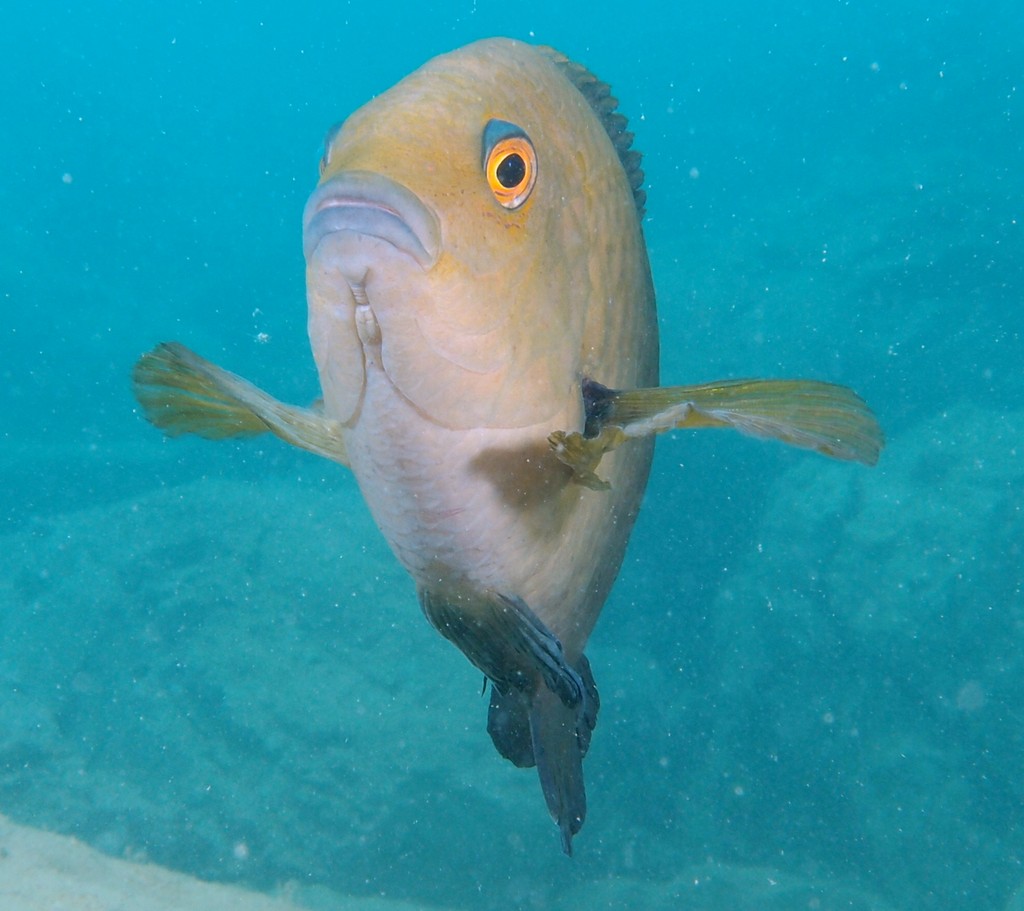HEMIGLYPHIDODON PLAGIOMETOPON - (BLEEKER, 1852)
Actinopterygii (Gigaclass) > Actinopteri (Class) > Teleostei (Subclass) > Blenniiformes (Order) > Pomacentridae (Family) > Pomacentrinae (Subfamily) > Hemiglyphidodon (Genus)
Lagoon damsel, Lagoon damselfish, Purple-spotted demoiselle, Sweetlip damsel, Giant farmer fish, Suzumedai-modoki, スズメダイモドキ, 密鰓魚,
Synonymes
Abudefduf melanopselion (Fowler, 1918)
Glyphisodon batjanensis (Bleeker, 1855)
Glyphisodon plagiometopon (Bleeker, 1852)
Hemiglyphidodon plagiometapon (Bleeker, 1852)
Hemiglyphidon plagiometopon (Bleeker, 1852)
-----------------------------
Description
Dorsal spines (total): 13; Dorsal soft rays (total): 14-15; Anal spines: 2; Anal soft rays: 14-15; Pectoral fin rays: 16-17; Lateral line scales: 14-16; Gill rakers (total first arch): 65-85; Body depth: 1.8-2.0 in SL. Max. length: 18.5 cm TL. Depth range: 2 - 20 m.
Color
Juveniles: dark blue to brownish anteriorly, yellow posteriorly and on the belly, with a large iridescent blue ocellus on the dorsal fin, and blue bands and spots anteriorly on the body.
Adults: brown body, sometimes with a paler orange-brown head gradually becoming darker towards the rear of the body, and pinkish markings on the gill cover.
Etymology
Hemiglyphidodon: from Greek, hemis = the half + from Greek, glyphis = carved + from Greek, odous = teeth. Glyphidodon, truncation of and replacement for Paraglyphidodon Bleeker 1877 when type species (oxycephalus) was moved to Chrysiptera. Glyphidodon is an unjustified emendation of Glyphisodon Lacepède, 1802 (=Abudefduf), referring to deeply notched teeth of Glyphisodon moucharra (=Abudefduf saxatilis).
plagiometopon: from Greek, plagios = oblique + from Greek, meta = with, after, behind + from Ancient Greek, óps = eye, face, appearance. Referring to its “very slanted profile”.
Original description: Glyphisodon plagiometopon Bleeker, 1852 - Type locality: Singapore.
Distribution
Eastern Indian Ocean and western Pacific: Andaman Sea, Malaysia and Indonesia, east to Palau, New Ireland (Papua New Guinea) and Solomon Islands, north to Philippines, south to northern Australia and New Caledonia.
Biology
Adults occur in protected lagoon and coastal reefs around branching corals, usually with lots of algae on coral bases on the substrate. Detrivore, although this territorial damsel fish actively defends algal covered territories, studies have shown that the species feeds mostly on fine detrital material. Very small amounts of algae and invertebrates such as polychaetes, crustaceans and foraminiferans are also consumed. The species has 2-3 times more gill rakers on the first arch than any other damselfish, which supports the fact that it feeds mostly on fine detritus. Oviparous, distinct pairing during breeding. Eggs are demersal and adhere to the substrate. Males guard and aerate the eggs.
Last update: 28, October 2024
Lagoon damsel, Lagoon damselfish, Purple-spotted demoiselle, Sweetlip damsel, Giant farmer fish, Suzumedai-modoki, スズメダイモドキ, 密鰓魚,
Synonymes
Abudefduf melanopselion (Fowler, 1918)
Glyphisodon batjanensis (Bleeker, 1855)
Glyphisodon plagiometopon (Bleeker, 1852)
Hemiglyphidodon plagiometapon (Bleeker, 1852)
Hemiglyphidon plagiometopon (Bleeker, 1852)
-----------------------------
Description
Dorsal spines (total): 13; Dorsal soft rays (total): 14-15; Anal spines: 2; Anal soft rays: 14-15; Pectoral fin rays: 16-17; Lateral line scales: 14-16; Gill rakers (total first arch): 65-85; Body depth: 1.8-2.0 in SL. Max. length: 18.5 cm TL. Depth range: 2 - 20 m.
Color
Juveniles: dark blue to brownish anteriorly, yellow posteriorly and on the belly, with a large iridescent blue ocellus on the dorsal fin, and blue bands and spots anteriorly on the body.
Adults: brown body, sometimes with a paler orange-brown head gradually becoming darker towards the rear of the body, and pinkish markings on the gill cover.
Etymology
Hemiglyphidodon: from Greek, hemis = the half + from Greek, glyphis = carved + from Greek, odous = teeth. Glyphidodon, truncation of and replacement for Paraglyphidodon Bleeker 1877 when type species (oxycephalus) was moved to Chrysiptera. Glyphidodon is an unjustified emendation of Glyphisodon Lacepède, 1802 (=Abudefduf), referring to deeply notched teeth of Glyphisodon moucharra (=Abudefduf saxatilis).
plagiometopon: from Greek, plagios = oblique + from Greek, meta = with, after, behind + from Ancient Greek, óps = eye, face, appearance. Referring to its “very slanted profile”.
Original description: Glyphisodon plagiometopon Bleeker, 1852 - Type locality: Singapore.
Distribution
Eastern Indian Ocean and western Pacific: Andaman Sea, Malaysia and Indonesia, east to Palau, New Ireland (Papua New Guinea) and Solomon Islands, north to Philippines, south to northern Australia and New Caledonia.
Biology
Adults occur in protected lagoon and coastal reefs around branching corals, usually with lots of algae on coral bases on the substrate. Detrivore, although this territorial damsel fish actively defends algal covered territories, studies have shown that the species feeds mostly on fine detrital material. Very small amounts of algae and invertebrates such as polychaetes, crustaceans and foraminiferans are also consumed. The species has 2-3 times more gill rakers on the first arch than any other damselfish, which supports the fact that it feeds mostly on fine detritus. Oviparous, distinct pairing during breeding. Eggs are demersal and adhere to the substrate. Males guard and aerate the eggs.
Last update: 28, October 2024
